MARKET OVERVIEW
The global veterinary services market serves as the most important section of the animal healthcare industry concerned with the provision of medical care, surgical treatment, and preventive healthcare solutions to a variety of animal species. This market responds to the increasing demand for specialized services required to maintain the health and productivity of companion animals as well as livestock. In the near future, the global veterinary services market will continue to contribute to animal health, public health, and safety, with increasing recognition of the interrelationship between human health and animal health in the various disciplines.
Veterinary services, in fact, encompass a very wide range of professional work, including diagnostic testing, disease management, routine check-ups, emergency intervention, and surgical procedures. As veterinary science moves forward, the global veterinary services market will likely include advances in technology such as advanced imaging, laboratory diagnostics, and telemedicine, all assisting veterinarians in providing accurate and efficient care. Because of this, veterinary clinics, hospitals, and mobile units will reach ever farther into rural and urban areas, even to remote populations, to get quality veterinary care.
The global veterinary services market will, due to the emotional and social worth that pets carry in the hearts of owners, provide companion animal services that will be increasingly demanded. This industry will play a significant role in offering wellness programs, vaccinations, dental care, and rehabilitation therapies aimed at prolonging the life and improving the quality of life for pets. On the livestock front, veterinary services will have a critical role in herd health management, focusing on disease prevention, productivity enhancement, and biosecurity issues that will address the requirements of food production systems.
As international trade in animal products continues to grow, keeping the health standards of livestock will be a matter of priority. The global veterinary services market will interlace itself into the global regulatory framework and certification processes for the purposes of controlling zoonoses and a safe food supply chain. The veterinary professional will be called upon not only to treat animals but also to advise on animal husbandry, vaccination programs, and outbreak response, thus contributing to the stability of agricultural economies.
The global veterinary services market will be increasingly subjected to disruption from R&D activities in the veterinary arena. New therapeutic regimes, vaccines, and diagnostic approaches will enter the field, and veterinary practitioners will need constant upgradation of their skills and facilities.
Global veterinary services market is estimated to reach $ 196,425.61 million by 2032; growing at a CAGR of 7.1% from 2025 to 2032.
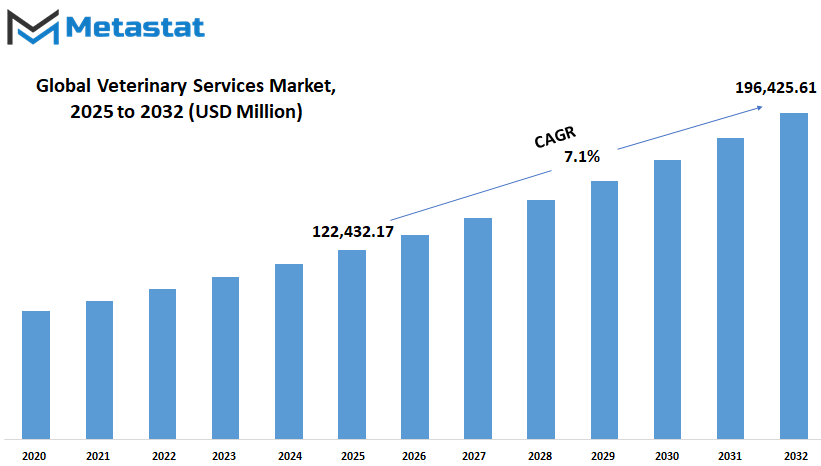
GROWTH FACTORS
The global veterinary services market remains challenged by some hurdles. In particular, there is a challenge from the high cost of veterinary appointments and advanced treatments. The high pricing could limit access to veterinary care for quality-conscious owners in lower-income regions. Limited availability of trained veterinarians on certain continents could dent the growth of market demand as well. While there is an upward demand for veterinary services, the available supply of qualified veterinarians in the market might not rise to the challenge of the growth curve, thereby tending to curtail the boundaries of service availability.
Undoubtedly, many factors have been responsible for the remarkable growth of global veterinary services market. There is increasing demand for veterinary care as more pets are being adopted globally. Health and welfare of pets are becoming a priority for many, with increased emphasis on preventive care, diagnostics, and treatments. Rising awareness among pet owners, putting veterinary services as a necessity, is simply driving the market. Also, increasing rates of adoption for pets in various regions have led to a sizeable demand for these services.
The other major aspect that has been contributing to market stimulation is the modernization of veterinary technologies towards improving efficiency and accessibility of veterinary health. Advances such as telemedicine and digital diagnostics are changing how veterinary services are actually rendered, affording remote consultations and rapid diagnoses. This, in turn, enhances the accessibility of veterinary services for pet owners in remote areas while improving the overall quality of care given to pets. The rise in smart wearables for pets, monitoring their health, and ultimately the emergence of filed-specific treatment are other significant drivers of the market.
Nevertheless, such hurdles also create considerable opportunities ahead of the global veterinary services market. Another promising opportunity lies in increasing investments for the development of innovative veterinary medicines and treatments. New and innovative options for maintaining the health and well-being of animals are ever in demand as ailments affecting both pets and livestock evolve over time. In addition, increased demand for alternative therapies and preventive health care services would be seen when pet owners seek specialized care of the highest standard. Thus, market expansion occasioned by facilitator trends towards personalized care might see the creation of new niche markets and provide an opportunity for phenomenal growth in the veterinary sector in the coming years.
In conclusion, it is important that the global veterinary services market also has its sets of challenges. Nevertheless, with a greater driving force in the form of fast-growing pet ownership, technology, or innovative services, this market lends view to a prosperous future. The many other opportunities dovetail with innovations to constitute the greatest gain for this global market.
MARKET SEGMENTATION
By Animal Type
The global veterinary services market has grown phenomenally over the ages because of advancing animal healthcare, increased awareness of the pet health, and growing focus on animal welfare. Several factors also augment the increase in veterinary demand with time as the market grows. A major such factor is an increased requirement for specialized care for diverse types of animals. The market is classified in zoonotic terms-on the types of animal that it grades companion animals and production animals. The main specializations that each animal type brings into its own category are based on their different needs resulting in numerous diversity-based growth opportunities in the sector.
Companion animals are mostly pets, traditional examples being dogs, cats, birds, and small mammals, which increasingly form part of the family unit across the globe. The brighter the future of these investments, the more demand rises for veterinary services that become preventive, curative, surgical, and holistic health manage-increasing adoption of pets, high per capita incomes, and a growing opening for scope have all contributed to rising market ambitions for commonly used animals. Services phasing in that future will go beyond regular care to advanced diagnostics, individualized treatment, and wellness programs for pets that encourage longer life with higher quality and longevity.
Production animals on the other side have different types of veterinary services, which include bovines, poultry, swine, and sheep. These animals are critical in providing food to the populace and are very important for agriculture. The health of these animals is, therefore crucial as it relates to the entire food supply chain globally. With the constant rise in the demand for products from animals for food, the veterinary services to maintain the health of production animals will grow. Such services would include management of diseases, improved breeding practices, and overall health to enhance production by these animals. Rising concerns for food safety might also lead to better provisions with regard to future biosecurity and disease prevention measures.
Going by both sectors, technology and innovation will shape the whole future of veterinary services. Increasing telemedicine applications, more wearable monitoring devices for health with animals, and a growing trend in artificial intelligence diagnostic process applications will boost the efficiency and effectiveness of veterinary care. These advancements will provide more quality services not only to companion animals but also to animals from the production sector and will make veterinary care more accessible and affordable to more and more regions around the globe. It will keep growing with time and keep focusing on specific animal types, their health needs, and the technology integration on the future path.
It is now a very promising future for any other investment as well; the more demand it generates, the better will be future visibility in preventive care, treatment of disease, surgery, and overall health management. The increasing trend of pet adoption, coupled with increases in average disposable income, has combined to push the market for veterinary services targeting companion animals higher. Such services are expected to move beyond standard care into advanced diagnostics, individually tailored therapies, even wellness programs for pets.
On the other hand, production animals are cattle, poultry, pigs, and sheep, which make up the different veterinary services, because these animals contribute vital roles in food production and agriculture, hence their health becomes critical and important to the global food supply chain. As demand for animal-based food products increases continuously, so will the need for maintaining production animal health via veterinary services. It will include disease management, breeding improvement, and overall health of these animals to optimize their productivity. Moreover, with ever-increasing concerns of food safety, there will now be greater strictness on biosecurity and disease prophylaxis in the future.
Thus, technology and innovation will shape the future of veterinary services in both sectors. Increasing use of telemedicine, increased availability of wellness monitoring devices for companion animals, and increased integration with artificial intelligence in diagnostic procedure contexts would further optimize efficiency and efficacy in the provision of veterinary services. These developments will not only enhance the quality of services to both companion and production animals but will also extend the coverage of veterinary care to larger populations across the globe.
It will keep growing in time while focusing attention to specific animal types, their health need, and technology integration on the future path. This is the place where the global veterinary services market is headed in the coming future conjunction with changes in the environment.
By Service Type
Rising demand for quality pet care across the globe has propelled growth in the global veterinary services market. With pets taking on family status, the demand for their health and well-being services is fast growing. The market has different kinds of services aimed at different kinds of animals, especially pets like dogs and cats. Other important drivers include the increase in pet ownership, advancement in veterinary medicine, and awareness regarding animal health.
Diagnostic tests and imaging constitute one of the main divisions of the global veterinary services market. They comprise services such as blood tests, ultrasound scans, and X-rays that help in identifying various clinical problems in the health of pets. These advancements help improve the quality and accuracy of currently available diagnostic tools in providing quicker and more accurate results. Advanced AI-assisted imaging technologies may well be embraced by veterinary practices in the future to accelerate faster and more accurate health problem detection, optimizing treatment options for the best care for the pets.
Monitoring physical health is another critical area within the veterinary services industry. The importance of keeping physical health records has increased due to the vast number of aging pets. For instance, there are current devices that track a pet’s activity, heart rate, and other health metrics. More advanced health-monitoring devices in a wear-and-tear form are expected to come as technology improves. These monitor tools could aid pet owners in following up on their pet’s well-being and allow vets to grab health issues before they become huge problems, thus increasing the chances for pets to live long and healthy lives.
Surgery remains an integral part of the veterinary services market. As pet care is becoming more advanced, surgical procedures on pets, from routine spaying and neutering to more complicated surgeries, are becoming increasingly common. In the future, it is expected that most veterinary surgeons would ramp up minimally invasive techniques for lesser risks and faster recovery time for pets.
Vaccination is another important veterinary service. Vaccinating pets against many diseases is critical to keeping their good health and limiting the spread of the infection. The pet vaccination sector will remain in the veterinary services market with state-of-the-art vaccines that assure safety and efficacy as research and development for vaccines continue.
Pet boarding and daycare have also been widespread lately. People from different walks of life lead hectic lives and rely on these services to watch over their pets while they are away. In the future, such services will continue to develop and will include specialized programs to care for pets with medical conditions or older pets requiring special care.
|
Forecast Period |
2025-2032 |
|
Market Size in 2025 |
$122,432.17 million |
|
Market Size by 2032 |
$196,425.61 Million |
|
Growth Rate from 2025 to 2032 |
7.1% |
|
Base Year |
2024 |
|
Regions Covered |
North America, Europe, Asia-Pacific, South America, Middle East & Africa |
REGIONAL ANALYSIS
The global veterinary services market is projected to witness continuous growth across various regions, primarily due to the increasing global awareness of animal health issues, advancements in veterinary care, and rising pet ownership. With this market growth, the different geographic regions will be bound to demonstrate their respective market developments with some attached challenges and opportunities in tandem.
North America will comprise the leading countries in the Veterinary Services market: the U.S., Canada, and Mexico. The United States is singled out with massive investments into the health sector for pets and livestock, with a very high demand for veterinary professionals. Sophisticated medical technologies, established health care infrastructure, and greater emphasis on preventive care give this region an added advantage to the growth of veterinary services. Also, the trend of pets being humanized and treated as family members shall continue to be an added benefit to speeding up growth in the veterinary service market.
The global veterinary services market is poised to advance in Europe as well, where key markets are based in the UK, Germany, France, and Italy. Europe has a developed health care system and an increasing number of pet owners, seeking high-quality care for their animals. Trends are favoring preventive veterinary services that are made possible by adopting advanced veterinary technologies, including telemedicine and robotic surgery, which are important factors likely to drive the market forward. However, certain limitations that include stricter regulations and economic condition in some countries hindering spending on veterinary services could adversely affect the market.
In this Asia-Pacific region, the demand for veterinary services is expected to gain momentum owing to fast-paced urbanization, increase in pet ownership, and growth in the livestock industry. Central to this growth will be China, India, Japan, and South Korea. For instance, in China, pet adoption has jumped to unprecedented levels, while the expanding middle class in India, coupled with the decision to treat pets as family, is bound to naturally escalate the demand for veterinary care. The increasing recognition of the importance of animal husbandry in several countries of the Asia-Pacific will also play a role in increasing market growth in this region.
South America, mainly Brazil and Argentina, will also witness increased demand for veterinary services in these countries. They have a large livestock sector that would require continuous veterinary support to maintain the health and productivity of the animals. Rising urbanization coupled with increased disposable incomes would also see an increased demand for the veterinary care services for pets.
Some unique challenges will be posed in the Middle East and Africa. While growth is expected for veterinary services in the GCC countries and South Africa, market expansion may not be easy due to restricted access and economic factors in specific regions. Nevertheless, increasing awareness about animal health and rising demand for the care of both pets and livestock will drive the growth of the sector in the long run.
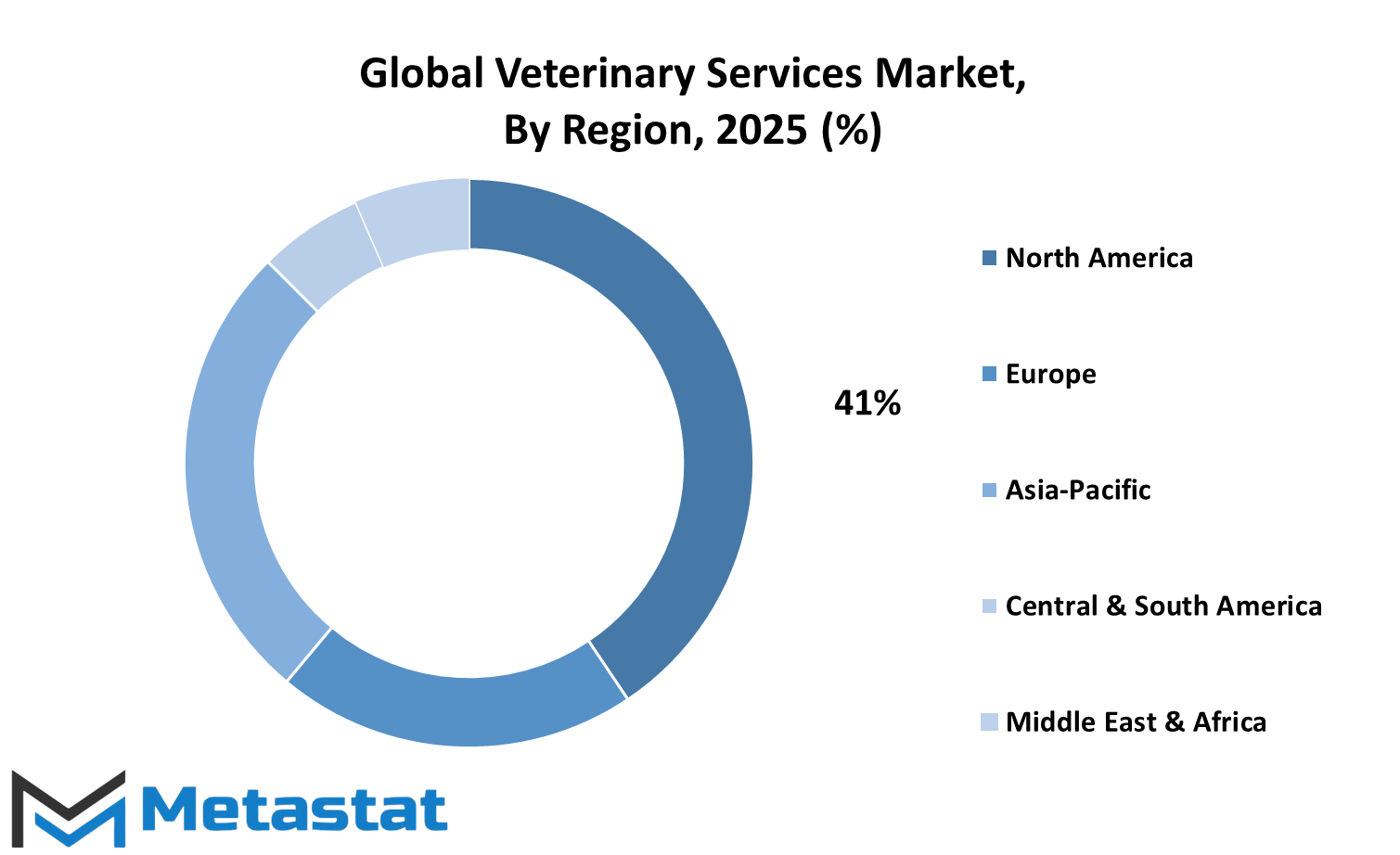
COMPETITIVE PLAYERS
The global veterinary services market has seen impressive growth over the years owing to increasing demand for animal health care services worldwide. This vertical is indispensable for maintaining pet, livestock, and animal health and addressing the growing issues associated with zoonotic diseases. The market comprises services ranging from preventive care, diagnostics, surgical procedures, emergency care, and rehabilitation. Veterinary services will evolve further as society lays greater stress on animal welfare, slowly responding to consumer taste and technological advancement.
Key players in the industry reshape the outlook of the global veterinary services market. Fetch! Pet Care, AniCura, and PetSmart are leading the change by providing various pet care services, including regular check-ups and emergency operations. Emphasis is placed on offering customized care suitable to individual pet needs, which dovetails with the popular tendency of pet humanization. As more people treat pets as family members, demand for premium-quality veterinary services is likely to rise. With Mars, Incorporated, in the forefront globally in pet care, Boehringer Ingelheim and Elanco support the development of veterinary pharmaceuticals and vaccines that considerably help in the prevention of animal disease.
Another two major players, Zoetis Inc. and Ceva Santé Animale, provide innovative solutions in veterinary medicine mainly diagnostics, biologics, and pharmaceutical products for the improvement of animal health, cattle productivity, and food safety. Phibro Animal Health Corporation, Greencross Limited, and CVS Group plc expand veterinary care in the market to deliver high-quality services to fulfil the ever-growing needs of pet owners.
Overall, the global veterinary services market is poised for a promising future driven by technological advancements, growth in the global pet population, and increased awareness of animal health. Witnessing the rise of telemedicine and digital health solutions, the market will most likely be witnessing a shift toward an unprecedented scale for accessible and convenient options for veterinary care. The likes of Virbac SA, PetIQ, LLC., and Hester Bioscience are expected to capitalize on these trends by setting up telehealth consultations, AI-based diagnostics, and remote monitoring devices, easing the workload of pet owners and livestock farmers in caring for their animals. Also, Scil Veterinary and VCA Inc. will most likely continue developing new products and stay in touch with veterinarians, ensuring that the sector keeps up with mounting demands and technological middle line.
Veterinary Services Market Key Segments:
By Animal Type
- Companion Animals
- Production Animals
By Service Type
- Diagnostic Tests and Imaging
- Physical health Monitoring
- Surgery
- Vaccination
- Pet Boarding and Daycare
- Other Services
Key Global Veterinary Services Industry Players
- Fetch! Pet Care
- AniCura
- PetSmart
- Mars, Incorporated
- Boehringer Ingelheim
- Elanco
- Zoetis Inc.
- Ceva Santé Animale
- Phibro Animal Health Corporation
- Greencross Limited
- CVS Group plc
- Virbac SA
- PetIQ, LLC.
- Hester Bioscience
- Scil Veterinary
- VCA Inc.
WHAT REPORT PROVIDES
- Full in-depth analysis of the parent Industry
- Important changes in market and its dynamics
- Segmentation details of the market
- Former, on-going, and projected market analysis in terms of volume and value
- Assessment of niche industry developments
- Market share analysis
- Key strategies of major players
- Emerging segments and regional growth potential



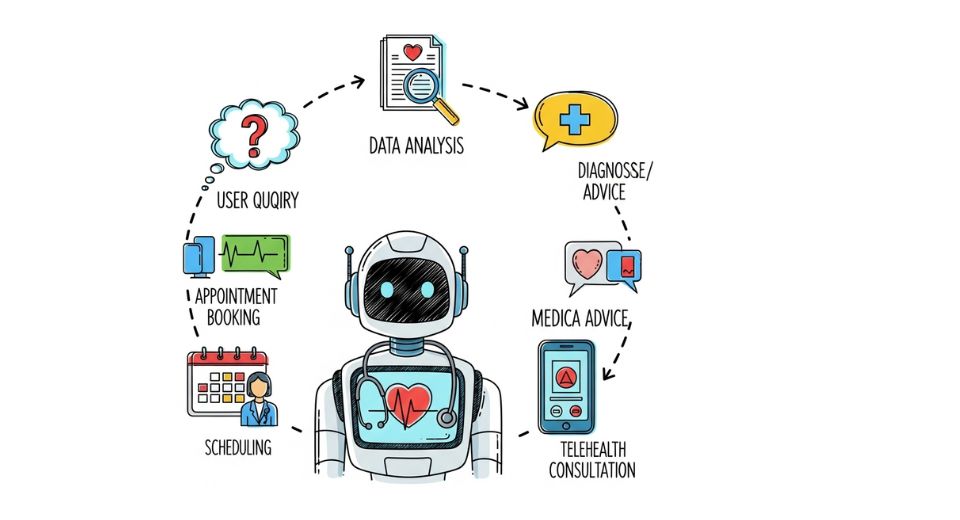
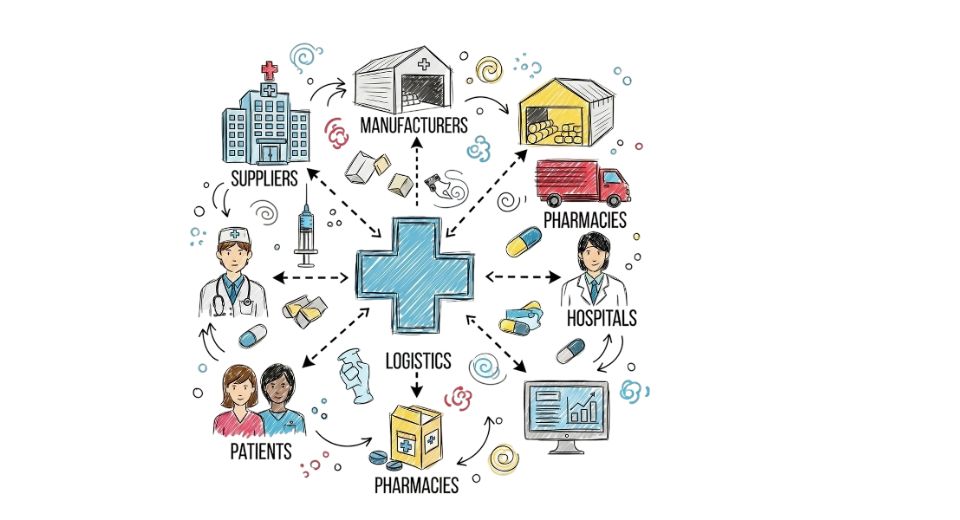
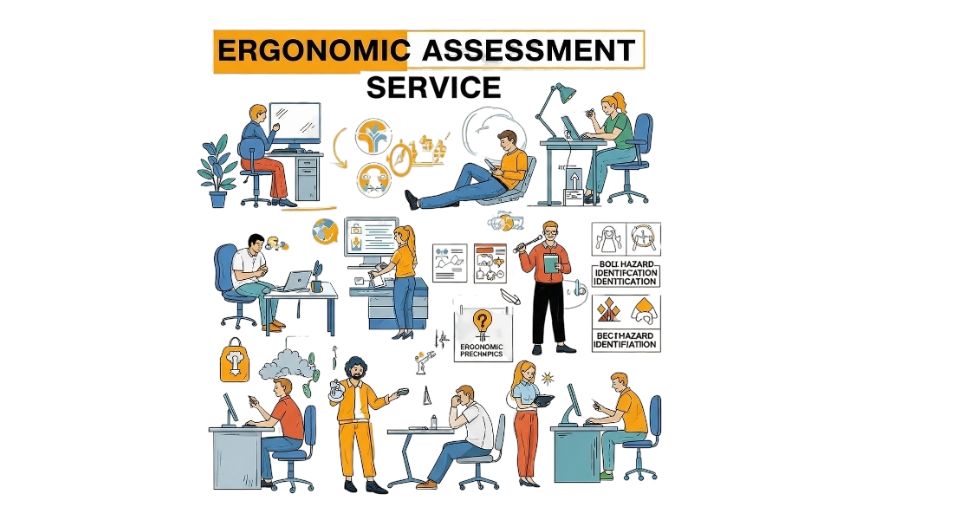
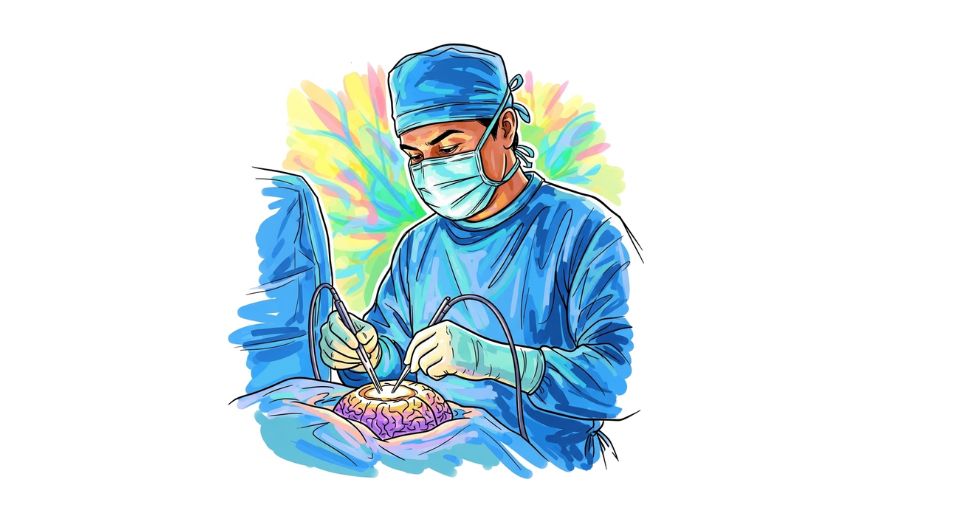
.jpg)
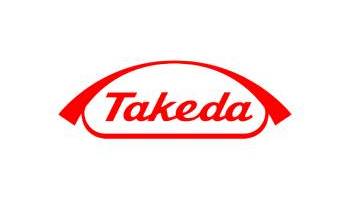
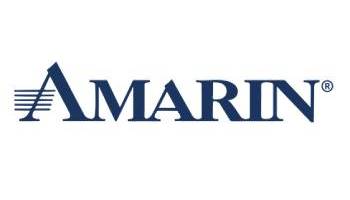

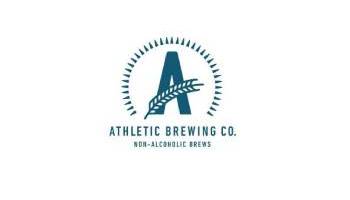
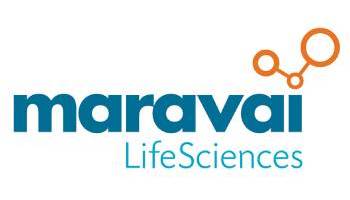
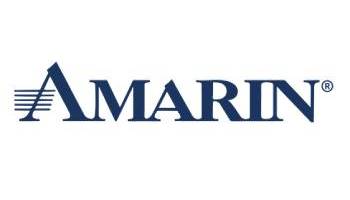
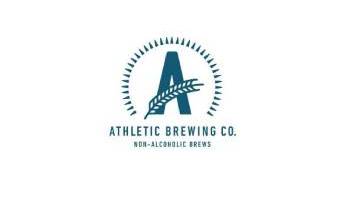

 US: +1 3023308252
US: +1 3023308252






